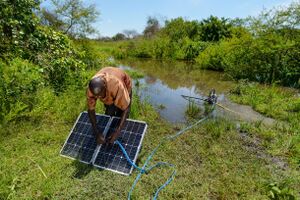Knowledge fuels change
For over a decade, Energypedia has shared free, reliable energy expertise with the world.
We’re now facing a serious funding gap.
Help keep this platform alive — your donation, big or small, truly matters!
Thank you for your support
Difference between revisions of "Access to energy for livelihoods in displacement settings"
***** (***** | *****) Tag: 2017 source edit |
***** (***** | *****) Tag: 2017 source edit |
||
| Line 1: | Line 1: | ||
| − | + | {[[ESDS Resource Page|ESDS back to link]]}<br/> | |
Revision as of 11:32, 8 February 2022
Overview
Access to energy is an important component of development to improve peoples’ livelihoods, their economic status and reduce poverty. Sustainable Development Goal (SDG) number seven, concerning universal energy access, is linked to all other SDGs, thus showing its importance in multiple aspects of improving peoples’ livelihoods. Well-planned energy strategies can provide significant benefits related to a number of factors. These include gender equality, food security, education, health, environmental protection, and livelihoods and jobs, amongst others. In contrast, poor energy access results in more people engaging in limited, low income livelihood activities, at the expense of other beneficial and sustainable opportunities
ESDS focuses on market-based energy solutions by providing global advisory services, implementing technical measures and cooperating with relevant stakeholders. As well as seeking to remedy the lack of sustainable energy supply in order to enhance the self-reliance in displacement settings communities in Ethiopia, Kenya and Uganda.
Value Chains create livelihood opportunities
Energy-related livelihoods can be defined as jobs or income generating activities that either form part of the value chain for energy products and services or link productive use of energy to other value chains, such as hospitality, service and agricultural value chains. It exists a number of value chains that can improve and/or create more livelihood opportunities for refugees and host communities. They have been grouped as follows:
- The energy value chain is generally composed of the upstream system (procurement of energy sources, for example, firewood), the production (transformation of sources into different forms of energy, for example, burning firewood for cooking) and the downstream system (distribution of the energy solution or service, after sales services and related services).
- The hospitality and services value chain represent an important opportunity for employment. This encompasses activities related to hostelry, restaurants, bars, hair dressing, carpentry, tailoring and entertainment, amongst others.
- The ICT value chain is interesting, as mobile phone penetration is becoming increasingly widespread and it is an important component for all other value chains.
- The agricultural value chains are also crucial, as they employ a high proportion of FDP in most of the displacement settings considered in this study.
Across the value chains, lighting is a proven impactful use of energy. Small business owners (mainly trade) see the benefits in using solar energy to provide power (longer business hours), and increase their access to information (radio) and communication (phone charging). A large number of small business owners also use the energy generated for domestic uses. This reduces energy costs and harmful health impacts associated with kerosene-based lighting, allows more children and youth to study and read at night, and improves security through outside lighting, therefore improving the general quality of life.




















